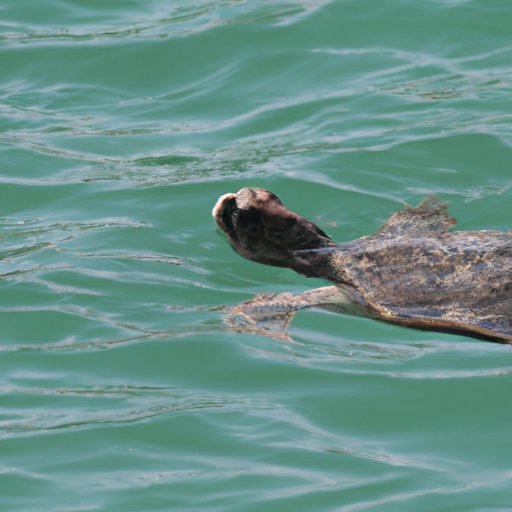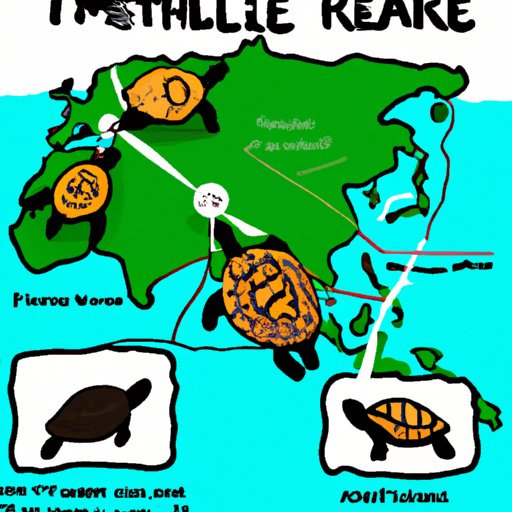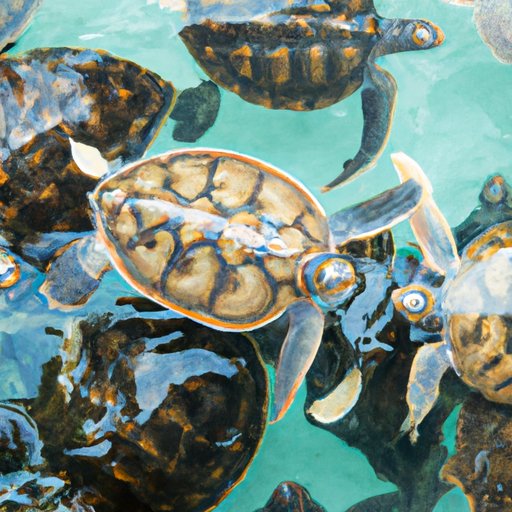Introduction
Turtles are remarkable creatures that travel great distances in their lifetime. Whether it’s through migration, swimming, or navigating their way around the world, these animals have the capacity to go incredibly far. But just how far do they travel? That is the question we will explore in this article.
Understanding turtle travel is important for helping us to protect these creatures and their habitats. By knowing more about their movements, we can better inform conservation efforts, as well as gain insight into the biology and behavior of these fascinating creatures.
In this article, we will look at the different methods used to track and map turtle travels, as well as explore the incredible distances they can swim and migrate. We will also examine the reasons behind these long-distance journeys and discuss what can be done to help conserve turtle populations.
Tracking the Long-Distance Travels of Turtles
To understand the extent of a turtle’s travels, scientists use various tracking methods. These include satellite tracking, radio telemetry, and biotelemetry. Satellite tracking involves attaching a transmitter to the turtle’s shell, which then sends out signals that can be picked up by satellites. Radio telemetry uses radio transmitters that emit low frequency signals, while biotelemetry involves surgically implanting transmitters inside the turtle’s body.
These tracking technologies have enabled us to observe some remarkable turtle travels. For instance, one loggerhead turtle was tracked traveling an astonishing 8,000 miles from its nesting beach in Florida all the way to Portugal. Another green sea turtle was tracked traveling a distance of 4,500 miles from Costa Rica to Europe. And a leatherback turtle was tracked covering a distance of 6,200 miles from Indonesia to Mexico.
Exploring the Incredible Migration Journeys of Turtles
Migration is an important part of a turtle’s life cycle. Different species of turtles have different migration patterns, but they generally migrate between breeding grounds and feeding grounds. For example, the loggerhead turtle migrates from its nesting beaches in the southeastern United States to feeding grounds in the Caribbean Sea.
The reasons behind these migration habits are still not fully understood, but there are several theories. One theory suggests that turtles migrate to take advantage of seasonal food sources. Another suggests that turtles migrate to avoid predation or extreme weather conditions. And a third theory suggests that turtles migrate to find mates or suitable nesting sites.

A Look at the Amazing Distances Turtles Swim
In addition to their migratory journeys, turtles also swim great distances. Depending on the species, turtles can swim anywhere from a few hundred miles to thousands of miles. The leatherback turtle, for example, is capable of swimming up to 3,100 miles in a single journey.
Turtles have certain physiological adaptations that allow them to swim such great distances. One adaptation is their streamlined shape, which reduces drag and increases speed in the water. Turtles also have flippers that help them to maneuver in the water, as well as a highly efficient respiratory system that allows them to stay underwater for extended periods of time.
The Wonders of Turtle Navigation: How Far Do They Go?
Turtles are also able to navigate their way around the world. The exact mechanism behind their navigational abilities is still not entirely understood, but there are several factors thought to play a role. These include magnetic fields, ocean currents, temperature gradients, and light intensity.
So, how far can turtles travel? There is no definite answer to this question, as it depends on the species, the environment, and other factors. However, we do know that certain species of turtles are capable of traveling vast distances. Some turtles have been known to travel thousands of miles in a single journey, while others can cover hundreds or even thousands of miles over the course of their lifetime.

Mapping the Incredible Travels of Turtles
In order to better understand the travels of turtles, scientists have developed a variety of mapping techniques. These include acoustic tracking, satellite tagging, and aerial surveys. Acoustic tracking involves using sound waves to track the movements of turtles, while satellite tagging involves attaching a transmitter to the turtle’s shell that emits signals that can be picked up by satellites.
Mapping turtle travels has numerous benefits. It helps us to gain a better understanding of the migratory patterns of turtles, as well as the threats they face in their journeys. It also allows us to identify potential areas for conservation and protection, which is essential for the survival of these creatures.
Conclusion
Turtles are incredible creatures that travel vast distances in their lifetime. Through tracking technologies and mapping techniques, we have gained insight into the incredible journeys they undertake. We now know that some turtles can migrate thousands of miles, while others can swim hundreds or even thousands of miles in a single journey.
These amazing travels highlight the importance of protecting turtles and their habitats. By understanding more about their movements, we can better inform conservation efforts and ensure the future of these incredible creatures.
(Note: Is this article not meeting your expectations? Do you have knowledge or insights to share? Unlock new opportunities and expand your reach by joining our authors team. Click Registration to join us and share your expertise with our readers.)
